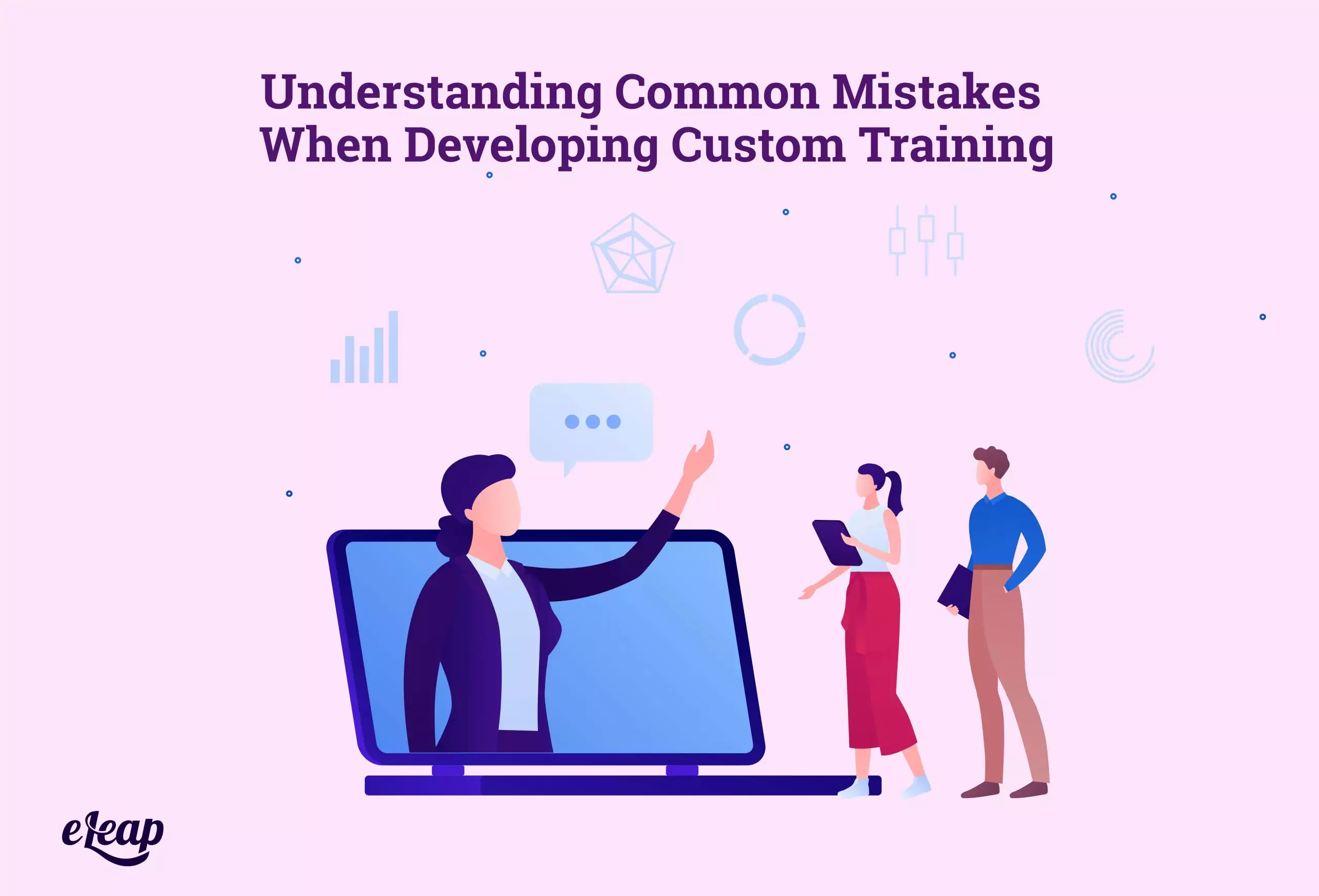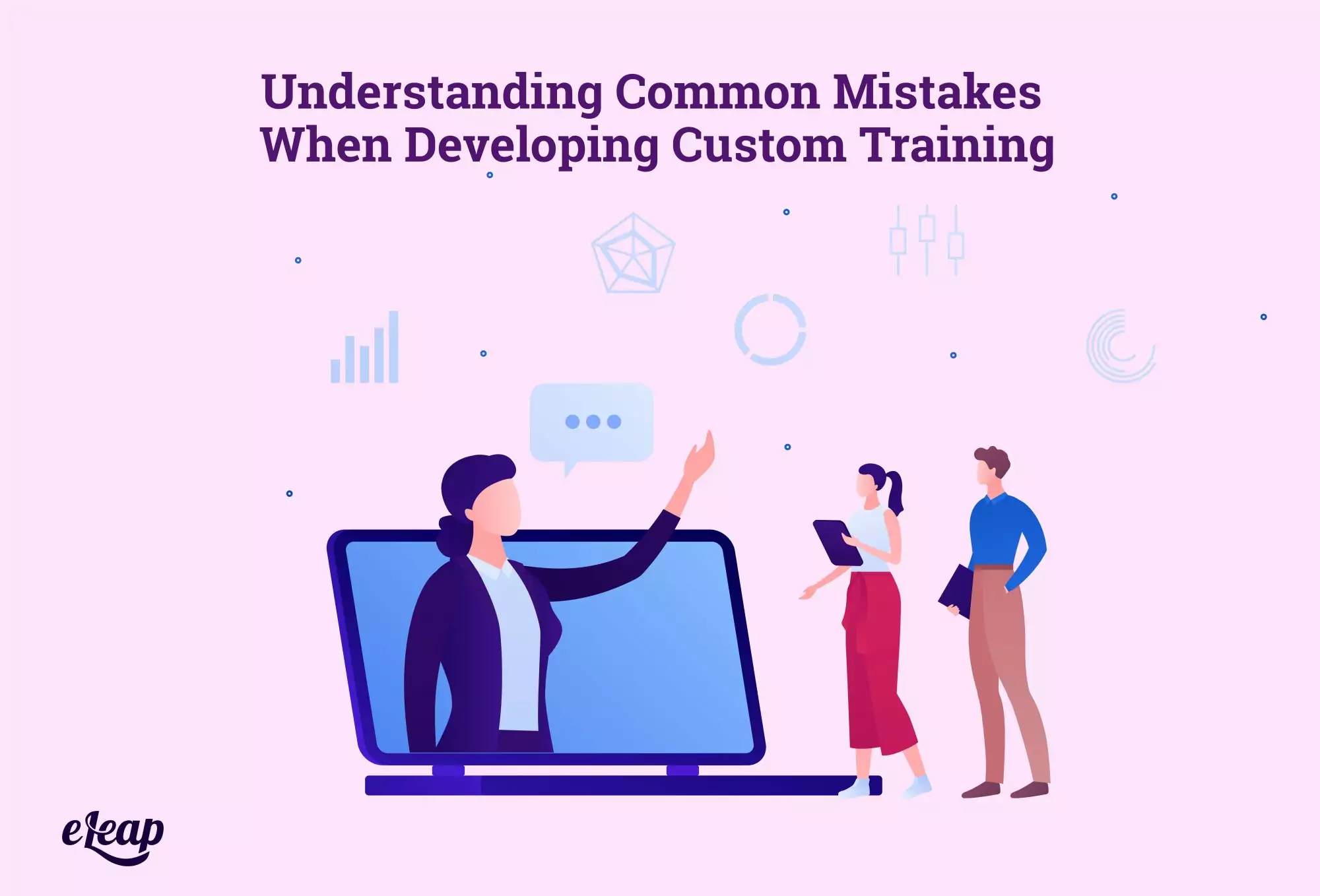Understanding Common Mistakes When Developing Custom Training

Pre-made learning content can be an invaluable asset. It allows you to get your L&D efforts off the ground quickly, without the time and expense involved with creating custom training. However, despite that value, “boxed” content is only good up to a point. Eventually, you will need to create custom content for your learners. When that happens, many organizations fall victim to some specific mistakes.
The good news is that these mistakes, while common, can be easily avoided. They can also be remedied with the right steps. By overcoming these issues, it becomes possible to create customized content steeped in your company’s culture, relevant to your learners, and designed to engage and help them thrive. In this post, we will explore some of these common mistakes, as well as the workarounds to circumvent them.

Why Does Custom Training Matter?
For those on the fence about the value of custom training development, let’s take a moment to explore why it’s critical for your L&D initiatives. Boxed, premade content can be valuable, and it certainly has its place. However, it does not:
- Connect with your corporate culture
- Tie in with learner experiences within your organization
- Support your organization’s stated values
By creating customized training, you can deliver a tailored learning experience for each person using your LMS. This includes creating customized learning paths, but it also touches on other areas. For instance, learners respond better to customized training, leading to better outcomes. It also becomes simpler to communicate key messages connected to corporate values or organizational needs.
The challenge, of course, is creating custom training that achieves those goals. That is not as simple as it might sound and the pitfalls along the way can be considerable.
Not Targeting Business Skills Development
One mistake that organizations make when developing custom content is failing to build skills critical to achieving business goals. This results in training that is largely irrelevant to the learner and the business. To overcome this, you must have a good understanding of the organization’s goals and objectives, as well as what skills are needed to reach them.
To develop that understanding, you should conduct a needs analysis, as well as a skills analysis. This will tell you where you need to go in terms of training direction, which skills are necessary, whether they’re present in the workforce, and give you a starting point to begin mapping company needs to employee performance objectives.
Lack of Learner Buy-In
It doesn’t matter how slick your animations are, or how high-quality your content is – if your learners do not buy into the content, it’s all for nothing. This mistake is primarily seen when organizations put more thought into design than relevance, particularly relevance to individual learners.
Today, there’s a greater and greater focus on customization. That doesn’t just mean content created for your company, but a custom learning path for each individual employee. A one-size-fits-all approach here simply does not work, and attempting to go that route will result in failure, no matter how amazing your content might be.
What’s the solution? Simply put, combine outstanding custom content design with a deep understanding of your audience. Every employee has unique needs, goals, and expectations. Realize that this is their journey and it becomes easier to create content that wraps around and supports their experiences rather than trying to shoehorn them into a single mold.
Training Fails to Change Behavior
All training should result in behavioral change. That’s the entire point. It’s not just about teaching an employee how to do something – it’s about instilling the understanding of why the desired actions are necessary and encouraging employees to move forward. For some situations, it is hard to use canned training. Something about that approach just doesn’t work quite as well. We should use custom training to target specific behavior change requirements when needed.
Often, this mistake is caused by a lack of learner engagement or a lack of meaningful impact. Learners need to understand several things to buy into your training, such as why it is relevant to them, why it matters in the long run, and how it dovetails not just with business objectives, but with their personal career goals.
Other reasons you may encounter this problem include if you’re attempting to do too much at one time and using the wrong delivery method. Learning is done best in small pieces. Consider cutting larger lessons into smaller chunks that allow your learners to digest the information better and retain it. For delivery method, experiment with different types – video, animation, games, social media, and more, to find the right mixture to support your efforts.
Expecting Learners to Succeed Yesterday
This mistake has more to do with planning than with the actual creation of custom content, but it bears discussing because content creation hinges on planning and delivery timelines. Unrealistic timelines can throw a serious wrench in the works. Short deadlines limit learners’ ability to interact with, understand, and absorb the information being taught.
Too often, leaders assume that learning and training are the same things. The thought is that a single training event should be enough to achieve real behavioral change. That’s usually not the case, particularly with deeper topics. Learning is a process that may require multiple events (individual training sessions) to really create lasting, meaningful change.
Getting around this problem will require that L&D work closely with leadership. Everyone must be on the same page in terms of deadlines and expectations. L&D must be able to rein in leaders who set unrealistic expectations, but that requires the department to have a seat at the table, something that’s not always true with today’s organizations.
Custom Content Wins the Day
Custom training content is an invaluable business asset. It speaks directly to your organization’s needs and goals, resonates with your values and ethics, and is steeped in your culture. However, there are many missteps along the path to custom content creation. Follow the tips above to avoid some of the most common mistakes here and be wary of others. And remember the golden rule – great learning content is engaging, supports your learners, and moves them forward toward your goals one step at a time.